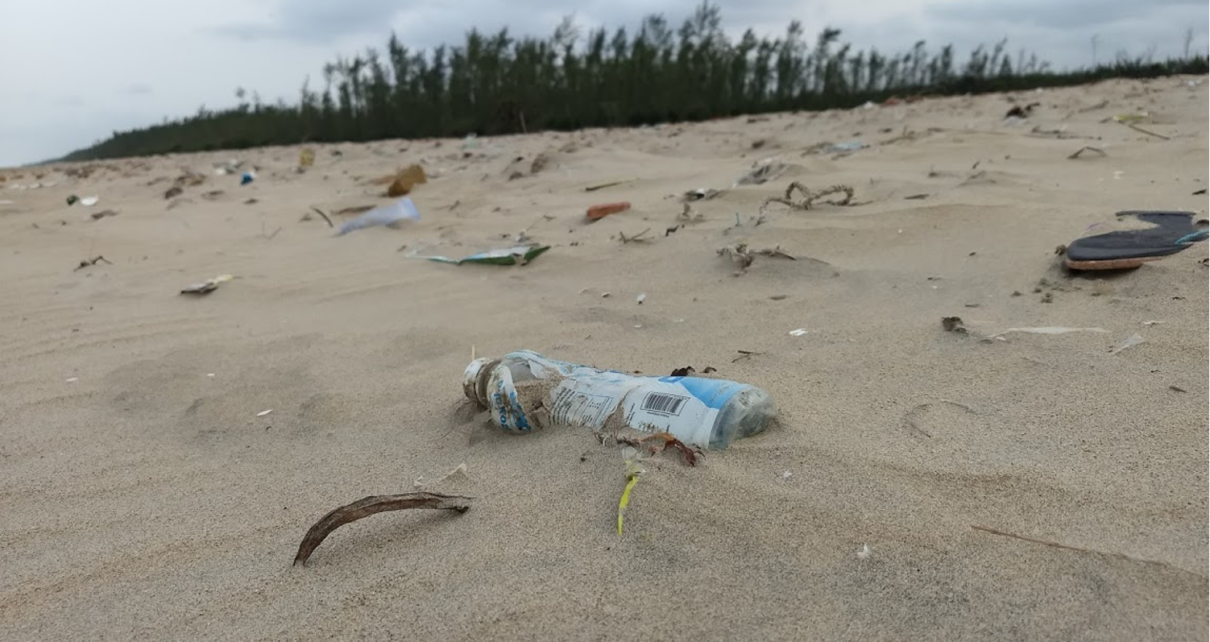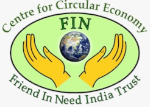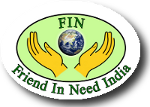
Cristina García Santos
FIN Intern – P2 Programme in Collaboration with Fusion Waste Management and Consultancy
The purpose of this blog post is to assess India’s role in tackling the issue of plastics. It is a crucial topic in the area of solid waste management as the production of plastic increases every year. This post uses the SITE framework (science, innovation, technology, engagement), focusing mainly on engagement, to analyse the efforts India is making in order to reduce the production and consumption of plastics, as well as recycling them properly.
Plastics, and the pollution they cause, have become one of the most pressing environmental issues of our time. The end of World War II entailed the growth of the production of plastics, bringing revolutionary solutions to different industries, such as medicine[i]. Yet, they also gave rise to a throw-away culture, where single-use plastics, those produced for immediate discard, account for 40% of the total production of plastics each yeari. Most single-use plastics have a lifespan ranging from minutes to a few hours; however, it might take hundreds of years to decompose, if it decomposes at all. The lifecycle of plastics depends on the type of product – plastic bags take 20 years to decompose whereas toothbrushes take 500 years – and their decomposition is different to other, more natural, products. Plastics break down into smaller pieces, which can be very dangerous to wildlife and, therefore, humans, especially if plastic ends up in the oceans[ii].
The plastic production of the last 15 years accounts for half of the plastics ever manufacturedi. Annual production of all-types of plastics has increased, globally, from 2.3 million tons in 1950 to 448 million tons in 2015i. Unless this trend is changed, it is estimated that production will double by 2050i[iii]. Plastics have replaced many materials and are used in a wide range of products. This is due to the low cost and the ease of manufacture, as well as their high resistance to light, temperature, and chemicals[iv]. It is estimated that, globally, plastic waste accounts for 10% of the total municipal waste. 79% of the total amount of plastics sent to landfills is transported to the oceans, whereas less than 10% is recycled and 12% is incineratediv. Plastics emit greenhouse gases, CO2 mainly, when burned. As most plastics contain certain additives, they become hazardous when they are released in the environmentiv. One of the biggest problems of their inadequate disposal is the amounts of plastics that end up in the oceans. The statistics are catastrophic: around 8 million tons of plastic waste goes into the oceans every year – 8 million pieces of plastic daily, accounting for 80% of all marine debris in oceans[v][vi].
 Plastic ends up in the ocean in different ways: the lack of recycling is one of the main ways as the plastic that is not recycle ends up in landfills, becoming easier to blow away by the wind when being transported and entering rivers and seas through drains; another way that plastic can get to oceans is by littering on the streets where rainwater and wind transport that plastic into rivers and seas; lastly, the products that go down the drain, when flushed down the toilet or when clothes are washed in the washing machine, break down into microfibres that are too small for waste water plants to filter and end up in oceans[vii]. Plastics that get to rivers are carried to seas, arriving to coastal waters, and transporting them in ocean currents. Plastics are, then, broken down into small particles by the sunlight, wind, and wave action. These are known as microplastics, and have been found everywhere in the world, including in municipal drinking water systemsi. Additionally, plastics may constitute new routes of contamination for other chemicaliv.
Plastic ends up in the ocean in different ways: the lack of recycling is one of the main ways as the plastic that is not recycle ends up in landfills, becoming easier to blow away by the wind when being transported and entering rivers and seas through drains; another way that plastic can get to oceans is by littering on the streets where rainwater and wind transport that plastic into rivers and seas; lastly, the products that go down the drain, when flushed down the toilet or when clothes are washed in the washing machine, break down into microfibres that are too small for waste water plants to filter and end up in oceans[vii]. Plastics that get to rivers are carried to seas, arriving to coastal waters, and transporting them in ocean currents. Plastics are, then, broken down into small particles by the sunlight, wind, and wave action. These are known as microplastics, and have been found everywhere in the world, including in municipal drinking water systemsi. Additionally, plastics may constitute new routes of contamination for other chemicaliv.
Yet, water pollution is not the only consequence; plastics also harm wildlife, killing millions of animals every year,  mainly by entanglement or starvation. It is known that about 700 species have already been affected by plastics, not only marine species but also land-based animals, like elephants or tigersi. Does all of this affect humans? The answer is yes. Microplastics have been found in more than 100 marine species which, then, end up in the food we eat and the water we drinki[viii]. This ingestion is likely to expose us to chemicals that are used in some plastics. These chemicals can cause organ problems or reproductive harm, among other health issuesviii. Given the novelty of the issue, there is yet not enough data to have a perspective of the bigger picture and certainly know in which ways it can affect human health; however, some of the chemicals, and their effect on health, are well-known and linked to interference with hormones, nervous system problems, and cancerviii. Moreover, it is extremely difficult to retrieve plastics from water bodies, especially when they break down into microplasticsi; therefore, it is of upmost importance to protect oceans and seas to avoid water pollution, which can be detrimental to wildlife and human health.
mainly by entanglement or starvation. It is known that about 700 species have already been affected by plastics, not only marine species but also land-based animals, like elephants or tigersi. Does all of this affect humans? The answer is yes. Microplastics have been found in more than 100 marine species which, then, end up in the food we eat and the water we drinki[viii]. This ingestion is likely to expose us to chemicals that are used in some plastics. These chemicals can cause organ problems or reproductive harm, among other health issuesviii. Given the novelty of the issue, there is yet not enough data to have a perspective of the bigger picture and certainly know in which ways it can affect human health; however, some of the chemicals, and their effect on health, are well-known and linked to interference with hormones, nervous system problems, and cancerviii. Moreover, it is extremely difficult to retrieve plastics from water bodies, especially when they break down into microplasticsi; therefore, it is of upmost importance to protect oceans and seas to avoid water pollution, which can be detrimental to wildlife and human health.
The issue of plastics in India
Plastic waste is a global issue, as it has been showed above and, therefore, it is also an issue that India is currently facing. As the production of plastics increases exponentially every year, it also increases the waste that needs to be disposed. India generates around 26,000 tonnes of plastic every day, as estimated by the Central Pollution Control Board (CPCB) in 2012, where more than 10,000 tonnes were not collected[ix]. Nowadays, these numbers are probably higher. The uncollected plastic waste ends up in the environment, either in the ocean or in the land, as explained above. The main challenge in the country is tackling the lack of awareness of the issue and the deficient solid waste management in cities[x]. Although there are different types of plastics, single-use plastics are the main concern of experts and policymakers, especially due to their short lifecycle and the amount produced. Single-use plastics are, therefore, India’s main problem, as it accounts for almost half of their production[xi][xii]. The use of plastics – and mainly single-use plastics – has risen not only because of traditional retail, but also due to the increased popularity of online shopping and food delivery appsix.

India’s per capita consumption of plastic was 11 kilogrammes in 2017, compared to the world average of 28 kilogrammesxi[xiii]. Yet, it is estimated to increase to 20 kilogrammes by 2022xiii. Even though India’s per capita consumption of plastics is lower than the world average and even lower than other countries, like the US, plastics still constitute a waste management and environmental issue when looking at absolute numbers, mainly due to the large population in India, second most populous country in the world. According to the Indian government, plastic accounts for 8% of the total solid waste of the countryxixiii. The lack of segregation at source of waste results in large quantities of plastic waste clogging public spaces and water bodiesxi. This impact can be seen in two main rivers in India that carry some of the world’s highest amounts of plastic waste to the oceans: the Indus and the Meghna-Brahmaputra-Gangesxi. Moreover, some seas in India are considered some of the most polluted in the world, such as the seas near Mumbai, Kerala, and the Andaman and Nicobar Islandsxiii.
India’s approach to the issue
In 2016, the Plastic Waste Management Rules were implemented with the objective to improve the legislation to ensure local bodies’ responsibility in managing wasteix. This responsibility starts by guaranteeing the proper infrastructure to segregate, collect, process, and dispose plastic waste. Since 2018, the rules also include an Extended Producers Responsibility (EPR), where producers and retail businesses are bound to collect back their generated plastic wasteixxii. Recycling plastic has proved to be a good option to address the issue, as almost 4 barrels of petroleum can be saved from recycling a ton of plastic wastexiii. Nevertheless, given the deficiencies in the system of segregation and recycling, most cities have not implemented the 2016 Rulesxii. The Rules, amended in 2018, lack yearly targets, clear steps to follow and financial support to their effective implementation[xiv]. According to the CPCB’s annual report of 2018, only 13 states submitted data on the status of implementation of the PWM Rules. The other 21 states have not submitted any information regarding the policy implementation[xv]. Even though most states effectively implementing the Rules are small states – like Andaman and Nicobar Islands or Lakshadweep – Andhra Pradesh, with a bigger size, is also successfully implementing the policy, submitting its complete reports to the CPCB and issuing violations of the rules[xvi].

In 2019, India’s Prime Minister, Narendra Modi, announced the ambitious target of eliminating single-use plastics by 2022, which accounts for almost half of the generated plastic in the countryixxi. Some big online companies, like Amazon India or Walmart, announced already in 2019 that they would start eliminating single-use plastics from their packagesixxi. Nevertheless, the implementation of this ban was left up in the air in early 2020 due to the slowdown in the Indian economy and the rise in unemployment[xvii]. Some states already took some small steps to implement the ban, yet the government did not take any national level initiativesxvii. The packaging industry is quite large in the country, as it employs around 4 to 5 million peoplexvii, which explains the slowdown from the national government regarding the ban of single-use plastics, given the economic situation of the country. Now, the pandemic has reversed the ban in some ways. State governments have relaxed the implemented restrictions on single-use plastics as they do not have the resources to control the increase in their use due to the pandemic[xviii]. We will have to wait until the negative effects of the pandemic are assessed to have a better idea of the next steps India will take to tackle the issue of single-use plastics. One thing is clear: the 2022 target announced by the national government in 2019 is, currently, unrealistic.

In Madhya Pradesh, the United Nations Development Programme (UNDP) has supported a project aiming at recycling single-use plastics that, otherwise, would have ended up in landfills, and use them to build roads and as fuel[xix]. Waste collectors in the cities of Bhopal and Indore are asked to bring plastic waste to their collection centres. Only in Bhopal, waste collectors pick around 10 tonnes of plastic waste every day[xx]. This provides additional income to waste collectors, one of the most vulnerable groups in Indian society as most of them are womenxixxx. The project is supported by the Global Environment Facility’s (GEF) Small Grants Programme (SGP), implemented by the UNDP, and it is carried out by a local NGO – Sarthak Samudayik Vikas Avan Jan Kalyan Sanstha (SSVAJKS) – in collaboration with municipal governmentsxx. The model that this NGO has implemented – known as the ‘Bhopal model’ –, consisting in reusing plastics in the construction of roads, is being replicated in all Indian states and Bangladeshxx.
Conclusion
Both the dimension and the impact of the issue make plastics an urgent matter that needs to be tackled worldwide. India is also facing this issue: even though India’s per capita consumption of plastics is lower than other countries their population size makes the problem even larger – especially as their population is projected to keep increasing. Yet, India is taking action to reduce their plastic consumption and waste. They are focusing on the different global practices, following the policies implemented by other countries like the ones in the EU or the UK[xxi]. The Plastic Waste Management Rules of 2016 and the 2018 amendment including the Extended Producers Responsibility set out the way forward for India regarding plastic waste and its consumption patterns. Although these rules are yet to be implemented completely and complied with in several states, the government set an ambitious target seeking to eliminate single-use plastics by 2022. However, it seems that the Covid-19 pandemic has brought to a standstill these environmental policies. Crucial decisions are coming for the governments as the consequences of plastic waste cannot be put on hold.
[i] Parker, L. (2019). The world’s plastic pollution crisis explained. Retrieved from https://www.nationalgeographic.com/environment/habitats/plastic-pollution/
[ii] WWF Australia. (2018). The lifecycle of plastics. Retrieved from https://www.wwf.org.au/news/blogs/the-lifecycle-of-plastics#gs.sehtzv.
[iii] Plastic Pollution Coalition. (2017). New global study shows the production, use, and fate of all plastics ever made. Retrieved from https://www.plasticpollutioncoalition.org/blog/2017/7/20/new-global-study-shows-the-production-use-and-fate-of-all-plastics-ever-made
[iv] European Parliament’s Policy Department for Citizens’ Rights and Constitutional Affairs. (2020). The environmental impacts of plastics and micro-plastics use, waste and pollution: EU and national measures. Brussels: Policy Department for Citizens’ Rights and Constitutional Affairs. Retrieved from https://www.europarl.europa.eu/RegData/etudes/STUD/2020/658279/IPOL_STU(2020)658279_EN.pdf
[v] Ocean Conservancy. (n.d.). Plastics in the Ocean. Retrieved from https://oceanconservancy.org/trash-free-seas/plastics-in-the-ocean/
[vi] International Union for Conservation of Nature (IUCN). (2018). Marine plastics. Retrieved from https://www.iucn.org/resources/issues-briefs/marine-plastics.
[vii] WWF. (n.d.). How does plastic end up in the ocean?. Retrieved from https://www.wwf.org.uk/updates/how-does-plastic-end-ocean.
[viii] Consumer Reports. (2019). You’re literally eating microplastics. How you can cut down exposure to them. The Washington Post. Retrieved from https://www.washingtonpost.com/health/youre-literally-eating-microplastics-how-you-can-cut-down-exposure-to-them/2019/10/04/22ebdfb6-e17a-11e9-8dc8-498eabc129a0_story.html.
[ix] Aravind, I. (2019). Just how bad is India’s plastic problem?. Retrieved from https://economictimes.indiatimes.com/news/politics-and-nation/how-india-is-drowning-in-plastic/articleshow/69706090.cms?from=mdr
[x] Pandey, S., & Manuja, S. (2020). Plastic Waste Management: Turning Challenges into Opportunities. TERI. Retrieved from https://www.teriin.org/policy-brief/plastic-waste-management-turning-challenges-opportunities?utm_source=newsletter29Jan2021&utm_medium=newsletter29Jan2021&utm_campaign=newsletter29Jan2021.
[xi] Phys.org. (2019). Five things to know about plastic waste and recycling in India. Retrieved from https://phys.org/news/2019-10-plastic-recycling-india.html
[xii] The Hindu. (2020). India’s plastic waste crisis. Retrieved from https://www.thehindu.com/sci-tech/energy-and-environment/watch-indias-plastic-waste-crisis/article30922725.ece
[xiii] TERI. (2018). Fact Sheet on plastic waste in India. TERI. Retrieved from https://www.teriin.org/sites/default/files/files/factsheet.pdf
[xiv] Agarwal, R. (2018). Centre amends Plastic Waste Rules, but misses out on strengthening implementation. DownToEarth. Retrieved from https://www.downtoearth.org.in/news/waste/centre-amends-plastic-waste-rules-2016-but-still-60084.
[xv] Shrivastav, R. (2019). India’s plastic waste situation wasn’t created today. DownToEarth. Retrieved from https://www.downtoearth.org.in/blog/waste/india-s-plastic-waste-situation-wasn-t-created-today-67061.
[xvi] Central Pollution Control Board (CPCB). (2019). Annual Report for the year 2018-19 on Implementation of Plastic Waste Management Rules. Delhi: Ministry of Environment, Forest and Climate Change, Govt. of India. Retrieved from https://cpcb.nic.in/uploads/plasticwaste/Annual_Report_2018-19_PWM.pdf
[xvii] Sampal, R. (2020). This is why Modi govt is going slow on single-use plastic ban. The Print. Retrieved from https://theprint.in/india/this-is-why-modi-govt-is-going-slow-on-single-use-plastic-ban/354888/.
[xviii] Poovanna, S., & Khanna, P. (2020). How covid-19 is reversing the ban on single use plastic across India. mint. Retrieved from https://www.livemint.com/news/india/how-covid-19-is-reversing-the-ban-on-single-use-plastic-across-india-11593608049382.html.
[xix] UN News. (2019). FROM THE FIELD: India’s plastic waste revolution. Retrieved from https://news.un.org/en/story/2019/12/1052551
[xx] Egan, A., & Currea, A. (2019). No Longer Going to Waste. UNDP – GEF – SGP. Retrieved from https://undp.shorthandstories.com/gef-sgp-no-longer-going-to-waste/
[xxi] Ministry of Environment, Forest and Climate Change. (2020). Uniform Framework for Extended Producers Responsibility (Under Plastic Waste Management Rules, 2016). Delhi: Ministry of Environment, Forest and Climate Change. Retrieved from http://moef.gov.in/wp-content/uploads/2020/06/Final-Uniform-Framework-on-EPR-June2020-for-comments.pdf

